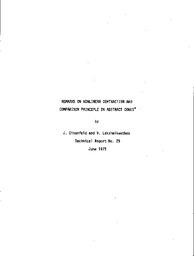
ATTENTION: The works hosted here are being migrated to a new repository that will consolidate resources, improve discoverability, and better show UTA's research impact on the global community. We will update authors as the migration progresses. Please see MavMatrix for more information.
Show simple item record
| dc.contributor.author | Lakshmikantham, V. | en |
| dc.contributor.author | Eisenfeld, Jerome | en |
| dc.date.accessioned | 2010-05-26T18:27:50Z | en |
| dc.date.available | 2010-05-26T18:27:50Z | en |
| dc.date.issued | 1975-06 | en |
| dc.identifier.uri | http://hdl.handle.net/10106/2180 | en |
| dc.description.abstract | **Please note that the full text is embargoed** ABSTRACT: The contraction mapping principle and the Schauder principle can both be viewed as a comparison of maps. For the former one has a condition of the type [see pdf for notation] and for the latter one has a condition of the type [see pdf for notation] where p is the metric and y is the Kuratowski measure of noncompactness. If p is a linear map [see pdf for notation] from the nonnegative reals [see pdf for notation] into itself then the map T satisfying (1.1) is said to be k-contractive and the map satisfying (1.2) is said to be k-set contractive. It is also usually assumed that k < 1 in which case the adjective "strict" is used to describe the contractive property. Instead of taking Y to be a linear map on the cone [see pdf for notation], can be chosen as a nonlinear map from a cone of a Banach space into itself [1], [4). This innovation provides for greater flexibility in the choice of and it also has the advantage of stronger convergence properties and more accurate estimates. The comparison map is: positive (in the sense that it takes values in a cone), monotone (nondecreasing) and has a unique fixed point which is the zero element of the cone. For a regular cone (such as cones in [see pdf for notation] needs only satisfy the weak continuity condition: upper semi-continuous from above (or from the right). However, in the case of a normal cone which is not regular (such as [see pdf for notation]) it is assumed in [1], [4] that y is completely continuous. The complete continuity condition which is also used by Krasnoselskii [7,p.127] may be replaced by a weaker compactness-type condition in terms of measure of noncompactness along with upper semi-continuity from above. We also manage to avoid strict contractive conditions. The paper is organized as follows. In Section 2 we state definitions regarding the theory of cones and some propositions which are used as lemmas or to amplify results proved later on. In Section 3 we present some results dealing with maximal fixed points of monotone maps. As a consequence we obtain a generalized Bellman-Gronwall-Reid inequality. In Section 4 we present a generalization of the contraction mapping principle. For applications see [1] - [4] and [6]. Also see [6] for modifications using minimal solutions in place of maximal solutions. | en |
| dc.language.iso | en_US | en |
| dc.publisher | University of Texas at Arlington | en |
| dc.relation.ispartofseries | Technical Report;25 | en |
| dc.subject | Abstract cones | en |
| dc.subject | Bellman-Gronwall-Reid inequality | en |
| dc.subject | Contraction mapping principle | en |
| dc.subject | Nonlinear map | en |
| dc.subject | Schauder principle | en |
| dc.subject.lcsh | Mathematics Research | en |
| dc.title | Remarks on Nonlinear Contraction and Comparison Principle in Abstract Cones | en |
| dc.type | Technical Report | en |
| dc.publisher.department | Department of Mathematics | en |
Files in this item
- Name:
- MathTechReport025.pdf
- Size:
- 408.9Kb
- Format:
- PDF
- Description:
- PDF
This item appears in the following Collection(s)
Show simple item record


